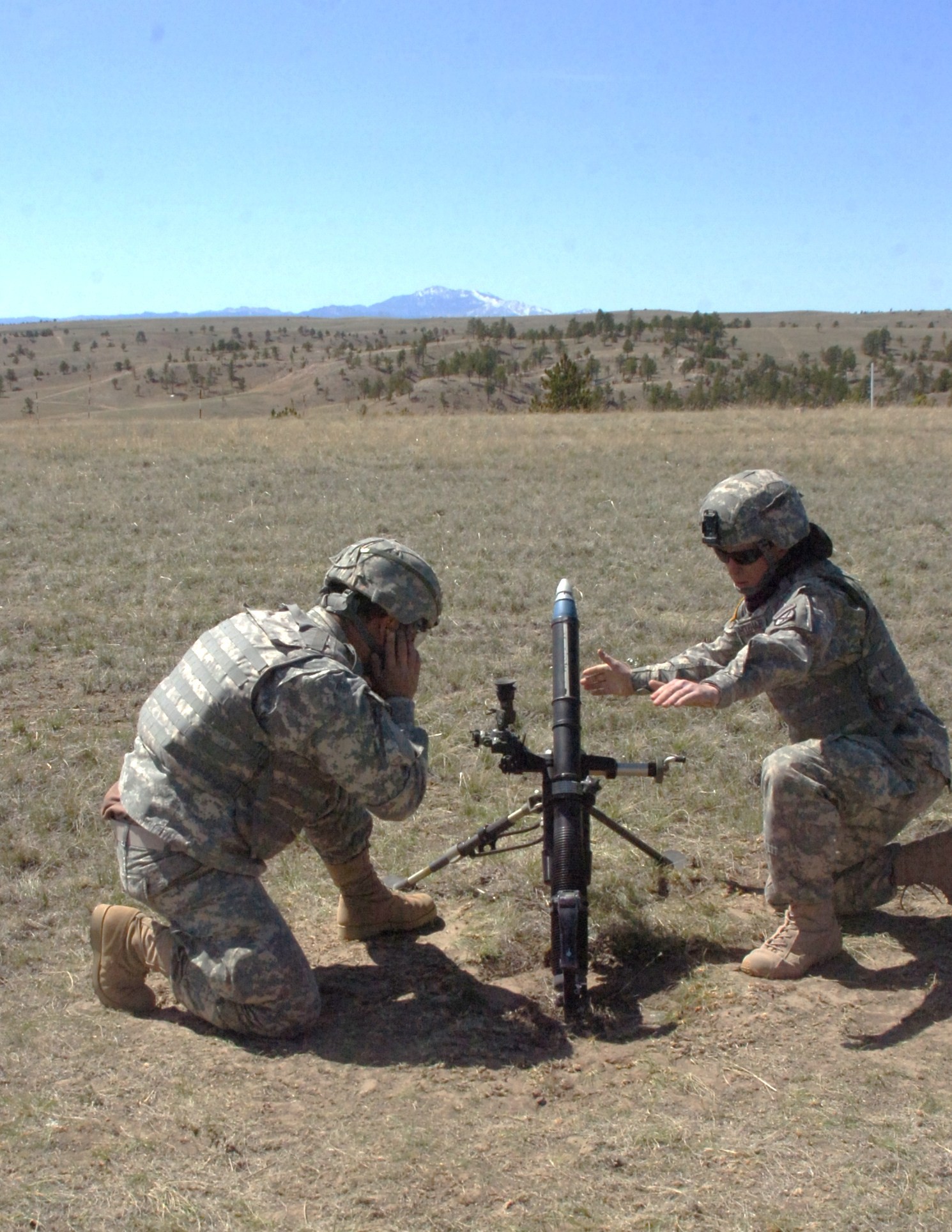
CAMP GUERNSEY, Wyo. - Mortar men from 3rd Squadron, 89th Cavalry Regiment conducted a consolidated live-fire exercise while training at Camp Guernsey, Wyo., April 14 and April 15.
Mortar crews from A, B and C Troops manned 60mm and 120mm mortar weapons systems for the live-fire exercise as forward observes from squadron Fire Support Teams (FiSTers) provided target coordinates. Sgt. Matthew Leue, Troop C mortar section chief, said the value of the live-fire training is "through the roof," because in Afghanistan, calling for indirect fire is going to be (a) key to keeping their cavalry scouts and infantrymen brethren alive.
"We should be 'pulling our triggers' at least once a month. Our primary MOS (Military Occupational Specialty) is to shoot ... (our individually assigned weapons), and our secondary MOS, of course, is (firing) mortars," said Leue. "Granted we are 11Cs (mortar men); but every Soldier should know how to fire his weapon accurately to be able to drop the enemy downrange, so trigger time is very important."
Spc. Brandon McGalin, squad leader for Troop A, said 13 mortar men from 3-89 Cav. participated in the live fire and that mortar men have to certify about every six months. McGalin said he is enjoying the training environment at Camp Guernsey, and consolidating all of the squadron's mortar crews for live-fire training makes for good group training too.
"It is going really good. We haven't had any problems," said McGalin. "Wind was a factor at first, trying to register (gage the weapons). Now we are Rock 'n' Rolling."
Leue also said the training went very well. However, from his perspective, it seemed as if the training at Camp Guernsey is one of the hardest things some of his newer Soldiers have ever done. While the Wyoming training exercise simulates the conditions and environment a deployment to Afghanistan, it is nothing compared to what the Soldiers will experience downrange in Leue's opinion.
"It is at least giving them an idea of what it is like," said Leue. "Five hours of sleep they think is not enough sleep, that is actually a blessing. Having to wear your gear for eight hours at a time, well that is a blessing within itself too; but, even for them, it is the first time they have been exposed to any type of real (combat-like) stress. Given the high altitude and the terrain, it is good training."
Through it all though Leue's Ghost Troop mortar section performed well. He said they were safe, effective and motivated, and he is pleased with their training performance. In fact every mortar man in Apache Troop's 60mm mortar crew who went through mortar qualification and certification testing before the live-fire exercise received an expert rating on qualification-certification exams, he said.
Leue's mortar crew is young and has only been together about four-to-five months. They started from ground zero but have built themselves into a well-oiled machine, and if one reviews the records, Leue's has the best mortar section in 3-89 Cav., he said.
McGalin referred to his team and squad as self-developing. They have been together about six months and are still developing as a team. The training at Camp Guernsey is bringing them even closer together, and their main objective is to be able to support Apache troop and 3-89 Cav. with accurate and quick fires, he said.
In addition to gunners' certifications and mortar life fire, all of the "Slugger" Squadron's mortar men conducted a multitude of marksmanship training, performed Individual Movement Techniques and practiced land-navigation. Proving their proficiency with these skills could be essential for the mortar men when they deploy to Afghanistan. This is especially true for the 60mm mortar crews in Afghanistan if they will be patrolling with scout platoons and need to be able to react to contact and break contact, said McGalin.
"Tomorrow morning we are going out (to the field), and we are going to stay out two days, giving the Soldiers bare minimum sleep, bare minimum food and humping in the mountains with the 60s," said McGalin. "(We will) do a bunch of hip shoots and some immediate suppression with the FOs, just basically get us ready for Afghanistan and get used to elevation, climbing mountains."
Leue said a mortar is a mortar is a mortar, and the crews should be able to fire all three mortar weapons systems. He also said high-altitude training in mountainous terrain is essential to the 60mm mortar sections.
"Depending upon the mission that comes down, we may very well be throwing our tubes on our rucksacks and marching out with the 11Bs - humping as far as them, as long as them," said Leue. "(They could come) ... into a direct-action situation where they are using their M-4s to engage the enemy or, if need be ... get set off on a mortar point to support the main effort."
Leue said 11Cs have to be prepared to perform every task and battle drill 11Bs do, along with the mortar drills and to maneuver mounted if need be. While mortar men are "Jack of all trades," said Leue, they are almost completely defenseless when performing their duties because their "hands are dropping rounds in the tube and (they) are looking down the sight pieces. Therefore, he believes, they need plenty of security around to safeguard them.
"McGalin said his troop can depend on his crew to support them with on time targets. Any time Apache Troop or any other squadron element need fires, McGalin and his mortar section will be there - on time and accurate, which in Afghanistan can mean the difference between life and death.
"The atmosphere in Afghanistan is that they are using mortars over there, so we really needed this training," said McGalin. "This is probably the best place that we could get to train for Afghanistan for mortars."

Social Sharing